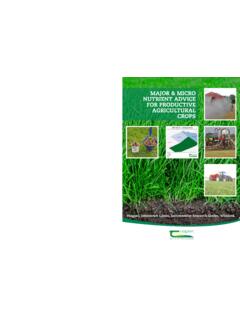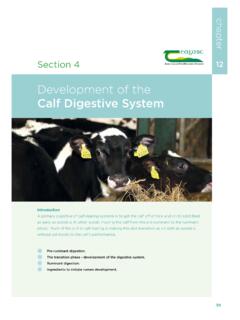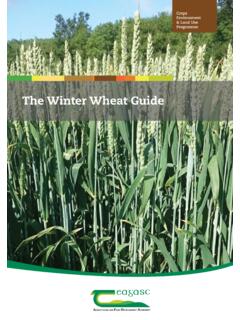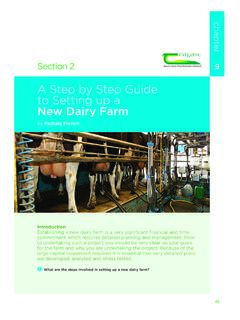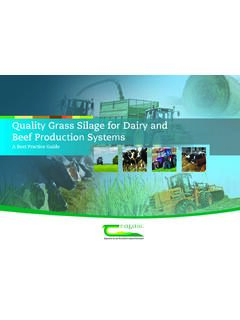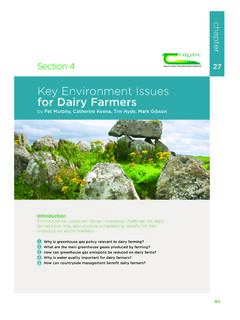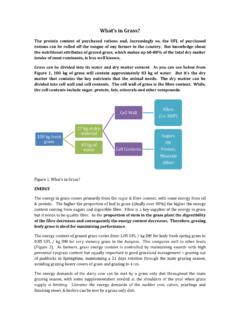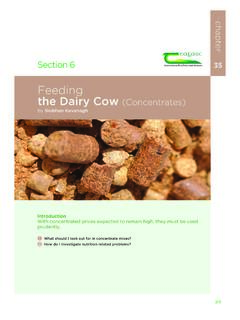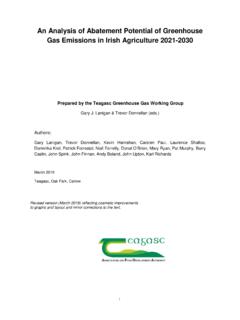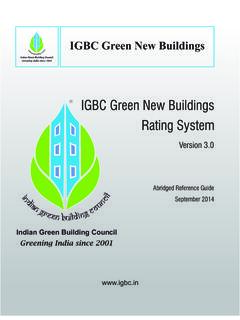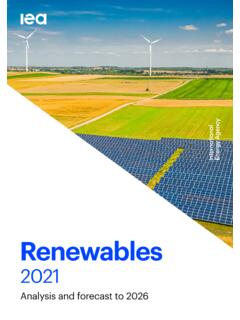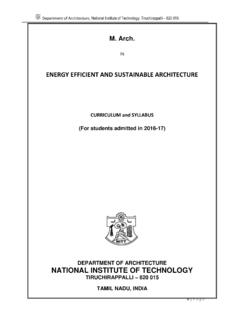Transcription of Improving Farm Sustainability - Teagasc
1 ImprovingFarm SustainabilityPractical tools for farmersPractical tools for 117/06/2019 13:12:251. Improved EBI and extending the grazing season2. Substituting clover for chemical fertiliser3. Changing to protected urea4. Reducing losses from slurry5. Improved energy effi ciency and renewable energy6. Incorporating forestry and hedgerows on farm7. Using the ASSAP advisors to help improve water quality7 Steps to Improving Farm Sustainability3. 1. Improved EBI Substituting 217/06/2019 13:12:27 Irish agriculture rightly has a global reputation for high environmental standards. However, these standards continue to become more stringent, and the expansion in dairying since milk quota removal is adding further pressure. Early action is key to meeting the environmental challenges of reducing greenhouse gas and ammonia emissions, increasing carbon capture, Improving water quality, protecting and Improving are a range of farm practices that dairy farmers can implement easily on their farms that can combine pro tability gains while contributing to meeting these Sustainability challenges.
2 Some of these are outlined in this practical guide of what you can do on your farm to help meet the environmental challenges. Practical measures include:1. Improved EBI and extending the grazing season2. Substituting clover for chemical fertiliser3. Changing to protected urea4. Reducing losses from slurry 5. Improved energy ef ciency and renewable energy6. Incorporating forestry and hedgerows on farm7. Using the ASSAP advisors to help improve water qualityFarmers can improve both their pro tability and improve the environmental Sustainability of their farms through adopting these straight forward practices. Collectively, this can contribute to the dairy industry playing its part in Ireland meeting the national and international environmental challenges. 317/06/2019 13:12:40 Improving the Sustainability of dairy farms requires a focus in two main areas.
3 Firstly, implementing technologies and practices on farms which reduce losses to the environment and secondly, Improving the ef ciency of the dairy system. Main Effi ciency MeasuresImproving genetics through increase EBI has an impact by: Improving fertility & survival - lower replacements and higher pregnancy rates Allowing earlier calving typically increases grazed grass in the diet Delivering higher milk solids yield from grazed grass Improved health - reduces deaths and diseasesA 20 EBI increase can lead to a 3% reduction in carbon footprintExtending the grazing season reduces emissions by: Lowering ruminant digestion emissions due to higher quality grass diet Lower quantity of slurry stored Lower energy usage Higher milk solids Improved protein contentA 10 day increase in grazing season can lead to reductions in carbon footprint and a 27 increase in profi t per cowIncorporating white clover into perennial ryegrass pastures Higher quality pasture - increased milk yield Lower chemical nitrogen requirement 100 kg/ha (250 kg/ha vs.)
4 150kg/ha)A well established white clover pasture will deliver a 10% reduction in carbon footprint (3% due increased milk yield; 7% due to reduction in chemical N fertilisation)On Farm Effi ciencies to Increase the Sustainability of Dairy Farms INCREASING 417/06/2019 13:12:48 Why use protected urea on your farm? PROTECTED UREAP rotected urea can replace both Urea and CAN to economically produce top grass yields on your farm at no net cost. It has the capacity to substantially reduce both GHG and Ammonia emissions and thereby safeguard Ireland s environmentally sustainable food production research demonstrates: Nitrogen fertiliser can be reduced when soil fertility is optimal Protected urea consistently and reliably produces top yields under spring and summer growing conditions. A 71% reduction in emissions of the Greenhouse Gas nitrous oxide using protected urea.
5 That protected urea is more ef cient than standard urea. More N is retained to grow grass. That protected urea makes urea safe from Ammonia-N loss. Protecting 50 kg/ha of urea-N will save 6 kg N/ha. In late spring 6 kg N will grow grass worth 40 / ha water Quality - Treated urea can help reduce losses to waterNitrate is readily lost to water during wet periods. Protected urea forms ammonium which is taken up by grass and is more stable in soil. A Teagasc fertiliser plan using protected urea can save 17/ha compared to an equivalent conventional plan! 517/06/2019 13:12:49 Best Practice in Slurry Spreading can reduce GHG and Ammonia Emissions and increase N retentionSLURRY MANAGEMENTUse Low Emissions Spreading Equipment Low emissions application technologies such as trailing shoe leads to reduced NH3 and GHG losses and increases the fertiliser replacement value of slurry Increased exibility of slurry applications on grazed pasture with Low Emission Slurry Spreading (LESS)
6 With lower contamination of grass Improved spreading accuracyIncrease the Proportion of Slurry Spread in Spring Spring application reduces emissions following land spreading due to the more favourable weather conditions cool, moist, calm, low sunlight Storage losses of methane are reduced due to the shorter storage period Reduced ammonia losses increases the fertiliser replacement value of slurry and reduces the fertiliser N requirement and associated manufacture and spreading emissionsIt is vital to factor in the increased utilisation of slurry N and reduce chemical N accordingly. Where there is a diffi culty using trailing shoe, trailing hose or umbilical systems should be 617/06/2019 13:12:52 Increasing Energy Ef ciencyAverage electricity costs on Irish dairy farms are 5 per 1,000 litres of milk produced. There is large variation in energy costs on dairy farms from to per 1,000 litres of milk.
7 Energy is used for: Milk Cooling (31%) The milking machine (20%) water heating (23%)Reducing Energy Emissions and CostIt is possible to reduce on farm electricity consumption, and related CO2emissions, by up to 60% and save over 2,500 (100 cow herd) by installing: An effective milk pre-cooler (plate cooler) A heat recovery system (recovery of heat from the cooling system for pre- heating of water ) Variable speed drives on the vacuum pump and milk pump as appropriate Micro-generator level solar PV system ( solar panels that generate on-site electricity). A newly announced TAMS grant is availableEnergy ef ciency and energy generation on dairy farms can reduce emissions and costDAIRY ENERGYThe fi rst steps in reducing energy costs are to estimate the amount of energy that is currently being used and to carry out an audit with your equipment provider to assess the potential for 717/06/2019 13:12:54At 12% of its land area, Ireland has one of the lowest levels of forest cover in Europe.
8 This is somewhat compensated by a high cover of hedgerows (4%) throughout the country. Because of their capacity to sequester carbon increased forest planting is essential to Ireland in meeting its greenhouse gas emissions targets. HedgerowsHedgerows are the dominant habitat feature on Irish farms, with the average dairy farm (56ha) having over 6km of hedges. Bene ts include: Providing shelter for stock and Improving biosecurity Forest plantations sequester 4 - 8 tonnes of C/ha/yr (with coniferous sequestering more than deciduous plantations). Hedgerows and non- forest woodland can sequester up to 1 ton of C/ha/yr Hedgerows and woodland act as buffers, intercepting overland ow, retaining sediment and phosphorus, thereby Improving water quality, and reducing ood risk Hedgerows act as a refuge for biodiversity and improve connectivity throughout the landscapeThe environmental bene ts of forests, woodland features and hedgerows are dependent on the quantity of these features, but also on their quality.
9 Improving hedgerow management should be focused on achieving the correct height and shape of hedges and laying or coppicing as appropriate to improve hedgerow quality. Routinely trimmed hedgerows should be cut to a minimum of from ground level, retaining individual thorn trees to ower and fruit, in every hedgerow. Forestry and WoodlandMost dairy farms have a capacity to have some forestry/woodland planted. The focus may vary depending on the circumstances including: Planting of commercial forestry on appropriate land as an investment Planting of native trees in copses, shelter belts or lines for biodiversity and for amenity and shelter around farm yardsFor biodiversity, existing habitats should be retained and not replaced with habitats. TREES & HEDGEROWSThe value of forest, woodland features and hedgerows on farms 817/06/2019 13:13:05 Irelands response to challenges around water quality is set out under the national River Basin Management Plan.
10 As a key part of this plan, 190 priority areas for action (PAA) have been identi ed across the country where water quality improvements need to be made. The local authorities have deployed a catchment assessment team of 60 scientists across the country to assess the PAA s in detail. Where an agricultural pressure is identi ed the advisors will work with farmers and offer a free farm visit under the ASSAP (Agricultural Sustainability Support and Advisory Programme).The ASSAP programme is delivered by 30 advisors (20 working under Teagasc jointly funded by DHPLG and DAFM and 10 from the dairy industry). These advisors are available to provide farmers with a free and con dential advisory service that farmers in a PAA can avail of on a voluntary will work to assist farmers to identify issues on their farm that are contributing to the problems identi ed in the catchment assessment.
